- 0044 (0) 207 351 8754
- [email protected]
- Royal Brompton Hospital - London
• When a child is having an asthma flare up they develop symptoms such as wheezing, dry tight cough, breathlessness and difficulty exercising. That is the time they need their reliever inhaler, known as a bronchodilator, as it opens up (dilates) the airways (bronchi).
• These inhalers are almost always in blue containers. Examples are salbutamol (trade names – Ventolin, Salamol, Airomir) and terbutaline (trade name – Bricanyl). Younger infants are sometimes given ipratropium bromide (trade name – Atrovent, which comes in a grey/white container with a green cap).
• These medicines should be given as and when they are needed to relieve symptoms rather than on a routine basis.
Bronchodilators may also be taken 15-20 minutes before exercise is due to begin, for those children who get exercise-induced asthma.
• During significant asthma exacerbations, salbutamol is given through spacer devices. Recommended doses are:
– Infants 2-4 puffs every 3-4 hours
– Small children 2-6 puffs every 3-4 hours
– Older children 2-8 puffs every 3-4 hours
– In accident & emergency up to 10 puffs may be given.
• If your child needs the reliever more often than this (e.g. after 1-2 hours), they should be given it and then medical attention must be sought in case stronger medication or oxygen are needed.
• Side effects are few, a slightly fast heartbeat or slight tremor if high doses are used.
• Children do not become dependent on them and should not be denied their use if they are having symptoms.
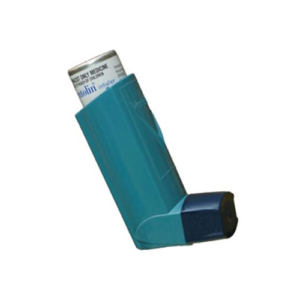
Bronchodilators (relievers) are usually in blue inhalers. Shown is salbutamol (in this instance Ventolin which is one of the many makes of salbutamol).

Ipratropium bromide (Atrovent) is another bronchodilator that is sometimes used in younger infants.
Bronchodilators can also be given as dry powder inhalers in older children. On the left is salbutamol (Ventolin) in an accuhaler (diskhaler), and on the right is terbutaline (Bricanyl) in a turbohaler.
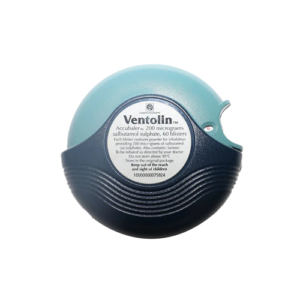

• Inhalers are best given through a spacer device as this gets the drug into the lungs in the most efficient way.
• Selecting the right device for the child’s age is crucial as if their technique is incorrect they will not get the benefit from the drug. This must always be checked by the doctor or nurse in clinic.
• Children under 3 years will need a spacer with a mask attached, for example an orange aerochamber (small infant), a yellow aerochmber (large infant/toddler), or an ablespacer (large infant/toddler). All makes of inhalers fit into these devices.
• If your child is crying or screamimg, the medicine will not get into the lungs. A spacer only works if a child is breathing calmly.
• Over 3 years of age the spacer can be used without a mask, and I tend to use the ablepacer or occasionally a blue aerochamber.
• Larger volume clear plastic devices also exist eg babyhaler, volumatic or nebuhaler but they can only be used with inhalers made by the company which makes the spacer device. Small volume spacers are more convenient for both handbags and school bags.
• Spacers should be cleaned every so often and left to drip dry.
• Over 5 years of age, a dry powder inhaler may be used, for example a Ventolin accuhaler or Bricanyl turbohaler. Children need to be able to hold their breath and count to 10 after each inhalation. Sometimes they are difficult to use if the child is having a bad attack as they cannot generate a large enough breath in. They are however convenient and fit easily into a child’s pocket or school bag.
• I never recommend using asthma metered-dose inhalers alone, they must always be used with a spacer device. They require complex coordination to make them work and studies have shown at least half of adults cannot use them properly.
Aerochambers
Use orange for small infants, yellow for older infants and blue (without the mask) for children aged 3 years and above. All inhalers can be used with these spacers.

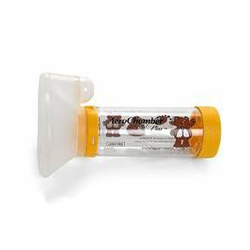


Ablespacer with a mask for infants and children under 3 years. All inhalers can be used with this spacer and the inhalers can be stored inside it.
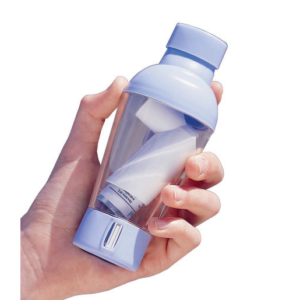
Ablespacer without a mask for children aged 3 years and above. All inhalers can be used with this spacer and the inhalers can be stored inside it.
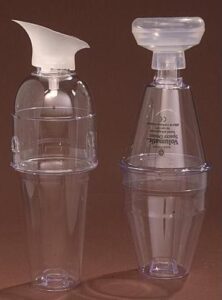
Large volume spacers. On the left is the Nebuhaler (terbutaline and budesonide can be used with this) and on the right the Volumatic (Salbutamol, beclometasone, fluticasone and salmeterol and seretide can be used with this). The mask can be removed for older children.
• If a child needs a reliever (bronchodilator) a few times a week regularly, or is having severe attacks requiring visits to hospital, they need to move up a step in therapy and start a regular preventer.
Inhaled steroids
• Inhaled steroids are the most effective type of drug to prevent asthma flare-ups. They reduce the inflammation seen in the airways of asthmatic children.
• They need to be taken regularly twice a day, regardless of symptoms. There is no benefit to doubling the dose when the child is unwell or has a cold. They are also not effective if given only during colds and when the child has symptoms, they take 4-6 weeks to start working.
• Examples are beclometasone (Trade names examples – Beclazone, Clenil, QVAR, all brown devices), budesonide (trade name Pulmicort, also a brown device) and fluticasone (Trade name Flixotide – orange device).
• These are best given through spacer devices, especially at higher doses, as the small droplets are inhaled into the lungs while the larger droplets remain in the spacer rather than staying in the child’s mouth where the drug can be absorbed. Lower doses can be given as dry powder inhalers – fluticasone can be given in an accuhaler and budesonide as a turbohaler.
• Side effects of steroids are always a concern for parents. However the side effects usually associated with steroids tend to be limited to high dose steroids taken by mouth for long periods. Inhaled steroids are generally very safe and any risk must be balanced by potential benefit. This is why they should only be used in children who truly have asthma (and inflamed airways). It is also why they should be used at the lowest dose possible to control symptoms.
• Side effects occasionally seen are thrush in the mouth (fungal infection) but this is rare when used through a spacer. A hoarse voice is also reported but almost never seen. The most important is the effect on growth, and whilst long term studies have shown that asthmatic children reach their predicted heights, there are a few children who are effected more obviously, but they are usually on high doses. Nevertheless, I always monitor height regularly in children taking these medicines.
Fluticasone (Flixotide) steroid inhaler to be given through a spacer device. The darker the inhaler, the higher the dose. Left hand is 50 mcg, middle one 125 mcg and right hand 250 mcg per puff.



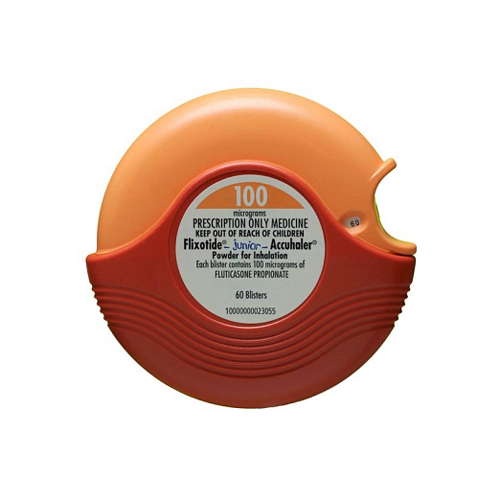
Fluticasone (Flixotide) steroid inhaler can also be given as a dry powder inhaler in a device called an accuhaler. It comes as different strengths – 100, 250 and 500 mcg per puff but I only use the lowest dose as a dry powder.

Budesonide (Pulmicort) steroid inhaler to be given through a spacer device. The darker the inhaler, the higher the dose. Beige inhaler on the left is the lower dose 50 mcg, the darker brown higher dose 200 mcg per puff.
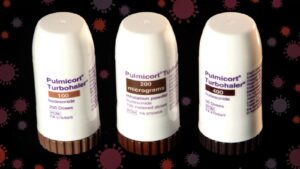
Budesonide (Pulmicort) steroid inhaler can also be given as a dry powder inhaler in a device called a turbohaler. It comes as different strengths – 100, 200 and 400 mcg per puff but I only use the lowest dose as a dry powder.
Inhaled steroids
If an asthmatic child is still not controlled satisfactorily on their inhaled steroids at a medium dose, it is time to add in a long-acting beta-agonist (LABAs), sometimes called ‘add-on therapy’.
• These work like bronchodilators to relax the muscles around the airway but work over a 24 hour period.
• They are not used instead of the short acting bronchodilators e.g. salbutamol, terbutaline.
• They must not be used unless the patient is already taking an inhaled steroid (which must be continued).
• Examples are salmeterol (trade name – Serevent) and formoterol (trade name – Oxis). They come in green or blue/green containers. Salmeterol can be used via a spacer device or as a powder (in an accuhaler), but formoterol is only in powder form (in a turbohaler).
• Side effects are few, most commonly a slight shaking of the hands if a child takes a high dose.
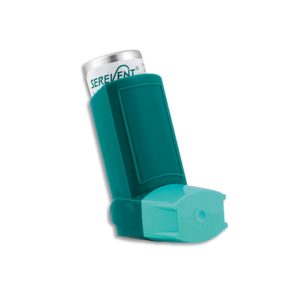
Salmeterol (Serevent), a long acting beta-agonist inhaler can be given through a spacer device and comes as one strength only – 25 mcg per puff.

Salmeterol (Serevent), a long acting beta-agonist inhaler can be given through a spacer device and comes as one strength only – 25 mcg per puff.
Formoterol (Oxis), a long acting beta-agonist inhaler comes only as a dry powder in a device called a turbohaler. The left hand one contains 6 mcg and the right 12 mcg per puff.
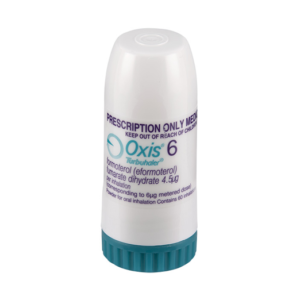

Combination inhalers
• If a child is taking an inhaled steroid and a long acting beta agonist, it may be possible to give the two drugs together in a comination inhaler. This does depend on whether the doses are in the right proportions.
• An example is Seretide (purple) which contains Serevent and Flixotide, and comes either as a dry powder via an accuhaler or a cannister that fits into spacer devices. The other is Symbicort which contains Oxis and Pulmicort and comes as a dry powder in a turbohaler with a red base.
Seretide combination inhaler (contains the steroid fluticasone and longacting beta agonist salmeterol) to be given through a spacer device. The darker the inhaler, the higher the dose. Left hand has 50 mcg, middle one 125 mcg and right hand 250 mcg of fluticasone per puff, whilst they all contain the same 25 mcg dose of salmeterol.

Seretide combination inhaler (contains the steroid fluticasone and longacting beta agonist salmeterol) to be given through a spacer device. The darker the inhaler, the higher the dose. Left hand has 50 mcg, middle one 125 mcg and right hand 250 mcg of fluticasone per puff, whilst they all contain the same 25 mcg dose of salmeterol.

Seretide combination inhaler (contains the steroid fluticasone and long acting beta agonist salmeterol) can also be given as a dry powder in a device called an accuhaler. It comes with different fluticasone strengths – 100, 250 and 500 mcg per puff, always with salmeterol at the same dose of 50 mcg per puff, but I only use the lowest dose as a dry powder.
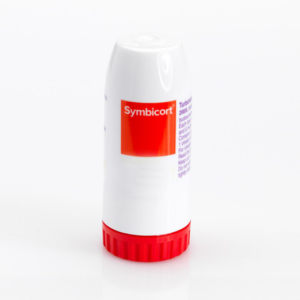
Symbicort combination inhaler (contains the steroid budesonide and long acting beta agonist formoterol) can only be given as a dry powder in a device called a turbohaler. It comes in different combinations – 100/6, 200/6, and 400/12; the budesonide dose is 100 or 200, the formoterol dose 6 or 12 per puff. I only use the lower dose as a dry powder.
Montelukast (Singulair)
• This is an oral medication that reduces airway inflammation so is also used as a preventer, but it is not steroid-based. It is taken once a day and traditionally given everyday. For those with significant asthma, it is usually added in to the inhaled steroids they are already taking. It may be tried first in younger children before inhaled steroids are started.
• It can also be used as an ‘as required’ medicine, meaning it is started at the first signs of a viral cold or symptoms (such as cough, wheeze), and taken daily for a few days to a week or at least until the symptoms have gone. This is because it starts to work within hours.
• This can sometimes be very effective for infants and toddlers who wheeze just with colds.
It comes as a chewable tablet for older children - or as granules (thick powder) for younger ones. The granules should be sprinkled on to cold food (e.g. youghurt, apple puree), they must not be put into milk or juice and not on to hot food.
• Side effects are not often seen, but older children can get headaches. Some children’s behaviour is affected and they may have bad dreams or disturbed sleep.
Acknowledgements to Royal Children’s Hospital Melbourne for many of the photographs of asthma devices reproduced with permission from their website –
(http://www.rch.org.au/clinicalguide/asthmadevices).
Share on facebook
Share on twitter
Share on linkedin
• When a child is having an asthma flare up they develop symptoms such as wheezing, dry tight cough, breathlessness and difficulty exercising. That is the time they need their reliever inhaler, known as a bronchodilator, as it opens up (dilates) the airways (bronchi).
• These inhalers are almost always in blue containers. Examples are salbutamol (trade names – Ventolin, Salamol, Airomir) and terbutaline (trade name – Bricanyl). Younger infants are sometimes given ipratropium bromide (trade name – Atrovent, which comes in a grey/white container with a green cap).
• These medicines should be given as and when they are needed to relieve symptoms rather than on a routine basis.
Bronchodilators may also be taken 15-20 minutes before exercise is due to begin, for those children who get exercise-induced asthma.
• During significant asthma exacerbations, salbutamol is given through spacer devices. Recommended doses are:
– Infants 2-4 puffs every 3-4 hours
– Small children 2-6 puffs every 3-4 hours
– Older children 2-8 puffs every 3-4 hours
– In accident & emergency up to 10 puffs may be given.
• If your child needs the reliever more often than this (e.g. after 1-2 hours), they should be given it and then medical attention must be sought in case stronger medication or oxygen are needed.
• Side effects are few, a slightly fast heartbeat or slight tremor if high doses are used.
• Children do not become dependent on them and should not be denied their use if they are having symptoms.

Bronchodilators (relievers) are usually in blue inhalers. Shown is salbutamol (in this instance Ventolin which is one of the many makes of salbutamol).

Ipratropium bromide (Atrovent) is another bronchodilator that is sometimes used in younger infants.
Bronchodilators can also be given as dry powder inhalers in older children. On the left is salbutamol (Ventolin) in an accuhaler (diskhaler), and on the right is terbutaline (Bricanyl) in a turbohaler.


• Inhalers are best given through a spacer device as this gets the drug into the lungs in the most efficient way.
• Selecting the right device for the child’s age is crucial as if their technique is incorrect they will not get the benefit from the drug. This must always be checked by the doctor or nurse in clinic.
• Children under 3 years will need a spacer with a mask attached, for example an orange aerochamber (small infant), a yellow aerochmber (large infant/toddler), or an ablespacer (large infant/toddler). All makes of inhalers fit into these devices.
• If your child is crying or screamimg, the medicine will not get into the lungs. A spacer only works if a child is breathing calmly.
• Over 3 years of age the spacer can be used without a mask, and I tend to use the ablepacer or occasionally a blue aerochamber.
• Larger volume clear plastic devices also exist eg babyhaler, volumatic or nebuhaler but they can only be used with inhalers made by the company which makes the spacer device. Small volume spacers are more convenient for both handbags and school bags.
• Spacers should be cleaned every so often and left to drip dry.
• Over 5 years of age, a dry powder inhaler may be used, for example a Ventolin accuhaler or Bricanyl turbohaler. Children need to be able to hold their breath and count to 10 after each inhalation. Sometimes they are difficult to use if the child is having a bad attack as they cannot generate a large enough breath in. They are however convenient and fit easily into a child’s pocket or school bag.
• I never recommend using asthma metered-dose inhalers alone, they must always be used with a spacer device. They require complex coordination to make them work and studies have shown at least half of adults cannot use them properly.
Aerochambers
Use orange for small infants, yellow for older infants and blue (without the mask) for children aged 3 years and above. All inhalers can be used with these spacers.




Ablespacer with a mask for infants and children under 3 years. All inhalers can be used with this spacer and the inhalers can be stored inside it.

Ablespacer without a mask for children aged 3 years and above. All inhalers can be used with this spacer and the inhalers can be stored inside it.

Large volume spacers. On the left is the Nebuhaler (terbutaline and budesonide can be used with this) and on the right the Volumatic (Salbutamol, beclometasone, fluticasone and salmeterol and seretide can be used with this). The mask can be removed for older children.
• If a child needs a reliever (bronchodilator) a few times a week regularly, or is having severe attacks requiring visits to hospital, they need to move up a step in therapy and start a regular preventer.
Inhaled steroids
• Inhaled steroids are the most effective type of drug to prevent asthma flare-ups. They reduce the inflammation seen in the airways of asthmatic children.
• They need to be taken regularly twice a day, regardless of symptoms. There is no benefit to doubling the dose when the child is unwell or has a cold. They are also not effective if given only during colds and when the child has symptoms, they take 4-6 weeks to start working.
• Examples are beclometasone (Trade names examples – Beclazone, Clenil, QVAR, all brown devices), budesonide (trade name Pulmicort, also a brown device) and fluticasone (Trade name Flixotide – orange device).
• These are best given through spacer devices, especially at higher doses, as the small droplets are inhaled into the lungs while the larger droplets remain in the spacer rather than staying in the child’s mouth where the drug can be absorbed. Lower doses can be given as dry powder inhalers – fluticasone can be given in an accuhaler and budesonide as a turbohaler.
• Side effects of steroids are always a concern for parents. However the side effects usually associated with steroids tend to be limited to high dose steroids taken by mouth for long periods. Inhaled steroids are generally very safe and any risk must be balanced by potential benefit. This is why they should only be used in children who truly have asthma (and inflamed airways). It is also why they should be used at the lowest dose possible to control symptoms.
• Side effects occasionally seen are thrush in the mouth (fungal infection) but this is rare when used through a spacer. A hoarse voice is also reported but almost never seen. The most important is the effect on growth, and whilst long term studies have shown that asthmatic children reach their predicted heights, there are a few children who are effected more obviously, but they are usually on high doses. Nevertheless, I always monitor height regularly in children taking these medicines.
Fluticasone (Flixotide) steroid inhaler to be given through a spacer device. The darker the inhaler, the higher the dose. Left hand is 50 mcg, middle one 125 mcg and right hand 250 mcg per puff.
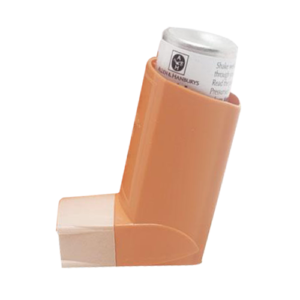
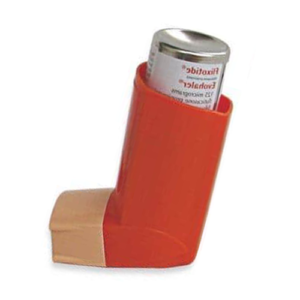
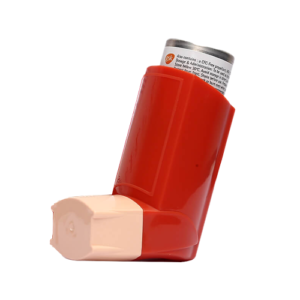

Fluticasone (Flixotide) steroid inhaler can also be given as a dry powder inhaler in a device called an accuhaler. It comes as different strengths – 100, 250 and 500 mcg per puff but I only use the lowest dose as a dry powder.

Budesonide (Pulmicort) steroid inhaler to be given through a spacer device. The darker the inhaler, the higher the dose. Beige inhaler on the left is the lower dose 50 mcg, the darker brown higher dose 200 mcg per puff.

Budesonide (Pulmicort) steroid inhaler can also be given as a dry powder inhaler in a device called a turbohaler. It comes as different strengths – 100, 200 and 400 mcg per puff but I only use the lowest dose as a dry powder.
Inhaled steroids
If an asthmatic child is still not controlled satisfactorily on their inhaled steroids at a medium dose, it is time to add in a long-acting beta-agonist (LABAs), sometimes called ‘add-on therapy’.
• These work like bronchodilators to relax the muscles around the airway but work over a 24 hour period.
• They are not used instead of the short acting bronchodilators e.g. salbutamol, terbutaline.
• They must not be used unless the patient is already taking an inhaled steroid (which must be continued).
• Examples are salmeterol (trade name – Serevent) and formoterol (trade name – Oxis). They come in green or blue/green containers. Salmeterol can be used via a spacer device or as a powder (in an accuhaler), but formoterol is only in powder form (in a turbohaler).
• Side effects are few, most commonly a slight shaking of the hands if a child takes a high dose.

Salmeterol (Serevent), a long acting beta-agonist inhaler can be given through a spacer device and comes as one strength only – 25 mcg per puff.

Salmeterol (Serevent), a long acting beta-agonist inhaler can be given through a spacer device and comes as one strength only – 25 mcg per puff.
Formoterol (Oxis), a long acting beta-agonist inhaler comes only as a dry powder in a device called a turbohaler. The left hand one contains 6 mcg and the right 12 mcg per puff.


Combination inhalers
• If a child is taking an inhaled steroid and a long acting beta agonist, it may be possible to give the two drugs together in a comination inhaler. This does depend on whether the doses are in the right proportions.
• An example is Seretide (purple) which contains Serevent and Flixotide, and comes either as a dry powder via an accuhaler or a cannister that fits into spacer devices. The other is Symbicort which contains Oxis and Pulmicort and comes as a dry powder in a turbohaler with a red base.
Seretide combination inhaler (contains the steroid fluticasone and longacting beta agonist salmeterol) to be given through a spacer device. The darker the inhaler, the higher the dose. Left hand has 50 mcg, middle one 125 mcg and right hand 250 mcg of fluticasone per puff, whilst they all contain the same 25 mcg dose of salmeterol.

Seretide combination inhaler (contains the steroid fluticasone and longacting beta agonist salmeterol) to be given through a spacer device. The darker the inhaler, the higher the dose. Left hand has 50 mcg, middle one 125 mcg and right hand 250 mcg of fluticasone per puff, whilst they all contain the same 25 mcg dose of salmeterol.

Seretide combination inhaler (contains the steroid fluticasone and long acting beta agonist salmeterol) can also be given as a dry powder in a device called an accuhaler. It comes with different fluticasone strengths – 100, 250 and 500 mcg per puff, always with salmeterol at the same dose of 50 mcg per puff, but I only use the lowest dose as a dry powder.

Symbicort combination inhaler (contains the steroid budesonide and long acting beta agonist formoterol) can only be given as a dry powder in a device called a turbohaler. It comes in different combinations – 100/6, 200/6, and 400/12; the budesonide dose is 100 or 200, the formoterol dose 6 or 12 per puff. I only use the lower dose as a dry powder.
Montelukast (Singulair)
• This is an oral medication that reduces airway inflammation so is also used as a preventer, but it is not steroid-based. It is taken once a day and traditionally given everyday. For those with significant asthma, it is usually added in to the inhaled steroids they are already taking. It may be tried first in younger children before inhaled steroids are started.
• It can also be used as an ‘as required’ medicine, meaning it is started at the first signs of a viral cold or symptoms (such as cough, wheeze), and taken daily for a few days to a week or at least until the symptoms have gone. This is because it starts to work within hours.
• This can sometimes be very effective for infants and toddlers who wheeze just with colds.
It comes as a chewable tablet for older children - or as granules (thick powder) for younger ones. The granules should be sprinkled on to cold food (e.g. youghurt, apple puree), they must not be put into milk or juice and not on to hot food.
• Side effects are not often seen, but older children can get headaches. Some children’s behaviour is affected and they may have bad dreams or disturbed sleep.
Acknowledgements to Royal Children’s Hospital Melbourne for many of the photographs of asthma devices reproduced with permission from their website –
(http://www.rch.org.au/clinicalguide/asthmadevices).
Share on facebook
Share on twitter
Share on linkedin